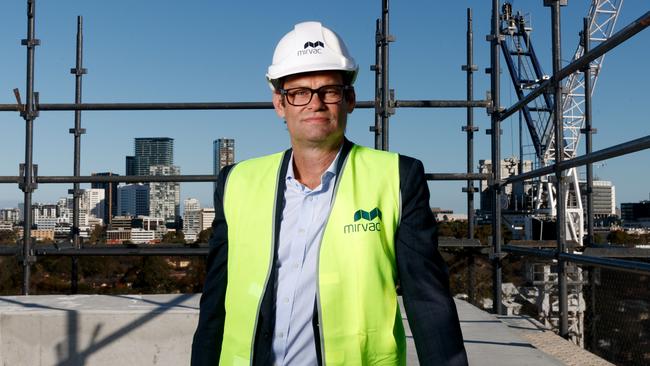Mirvac bottom line hit by property devaluations
Mirvac boss Campbell Hanan says higher density development in cities and improvements to planning regimes will be key to unlocking more new housing.

Mirvac boss Campbell Hanan says higher density development in Australian cities and improvements to the country’s planning regimes will be key to unlocking more new housing and improving affordability for buyers and renters.
The diversified property group provides a mix of housing including apartments, traditional house and land packages, as well as accommodation in the emerging build-to-rent and land lease sectors.
Mr Hanan said that while all segments of the market were part of the solution to boosting supply, apartments in particular had proven to be an affordable option for buyers that didn’t require major investments in new infrastructure.
“The fact that we’ve got a federal government that is focusing on the Housing Affordability Fund, albeit it’s not approved yet, demonstrates that the government is really focused on the supply challenges we have in front of us and the affordability issues that are there as well,” he said.
“And the bits that certainly we’re focused on is just how they can make the planning processes better than they are because they are not really as effective as they could be.
“There’s a lot of positive language around the fact that cities are going to need to change the nature of how they develop, going up rather than going out, and I think that’s an important element of all of that infrastructure spend that we’ve seen over the last 10 years.
“Certainly when we look at the affordability of an apartment relative to a house we think that’s going to change the nature over time of how people think about apartment living.”
Mr Hanan said a three-bedroom apartment typically traded at a 20 per cent discount to a three-bedroom house in a similar area, and that gap had increased to 50 per cent during the pandemic.
His comments followed the release of Mirvac’s full-year results for the 12 months to June, which revealed how commercial property devaluations were hitting the bottom line of the country’s largest landlords.
Mirvac reported a statutory loss of $165m for the 12 months to June, down from a $906m profit in the previous year.
Devaluations stripped $528m from the company’s profit, with the value of its office and retail portfolios lowered by 5.6 per cent and 5.3 per cent, partially offset by a 6.2 per cent increase in the value of its industrial property holdings.
Total revenue was down 31 per cent to 1.97bn, with weather and labour shortages partly behind a 9 per cent fall in residential settlements to 2298 lots.
Operating profit was only slightly lower than the previous year, down 3 per cent to $580m, representing 14.7 cents per stapled security. That was in line with the group’s revised guidance provided in April and consensus estimates.
Mr Hanan said that while an uncertain economic outlook and the shift to flexible styles of work had posed a challenge for office markets, a flight to quality continued to generate strong demand from tenants seeking high quality accommodation.
“I think there’s some interesting challenges in the office sector but I think for the first time in a long time there is a real diversity between those assets that will do better than others,” he said.
“Certainly our view is that premium grade assets are performing well. On a relative basis we have one of the highest percentages of premium grade assets in our portfolio, which is by design and development capability over a long period of time.
“I think there are some older A-grade assets that are struggling, particularly if they’re not in the heart of the CBDs, and even more so if they’re in suburban fringe markets.
“I think there are winners and losers in office markets more so than there has been in the past.”
Mirvac’s operating earnings guidance for 2023-24, of 14 cents to 14.3 cents per stapled security, left some analysts disappointed. They were expecting a 14.5 cents return.
In a note to clients, analysts at Citi said Mirvac continued to face risks to its property valuations.
“Other specific risk considerations include a capital-intensive and development exposure to the residential property market, which in turn is impacted by interest rate changes, housing affordability and new construction,” they said.
“Mirvac also has a high weighting to office property, returns of which are subject to changes in the level of business confidence, employment growth and competitive supply.”
Mirvac will pay a final distribution of 5.3 cents on August 31, bringing its full-year payout to 10.5 cents, up 3 per cent from the previous year.
The company’s shares were trading 4.2 per cent higher on Wednesday at $2.38.





To join the conversation, please log in. Don't have an account? Register
Join the conversation, you are commenting as Logout